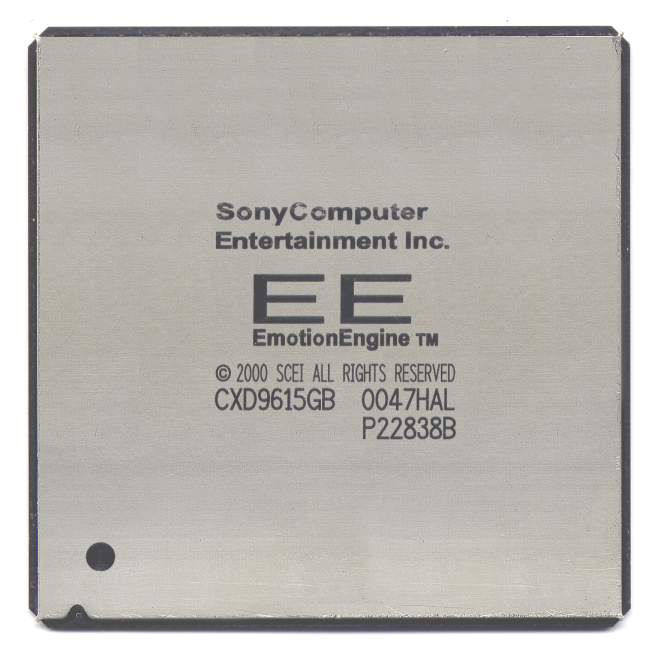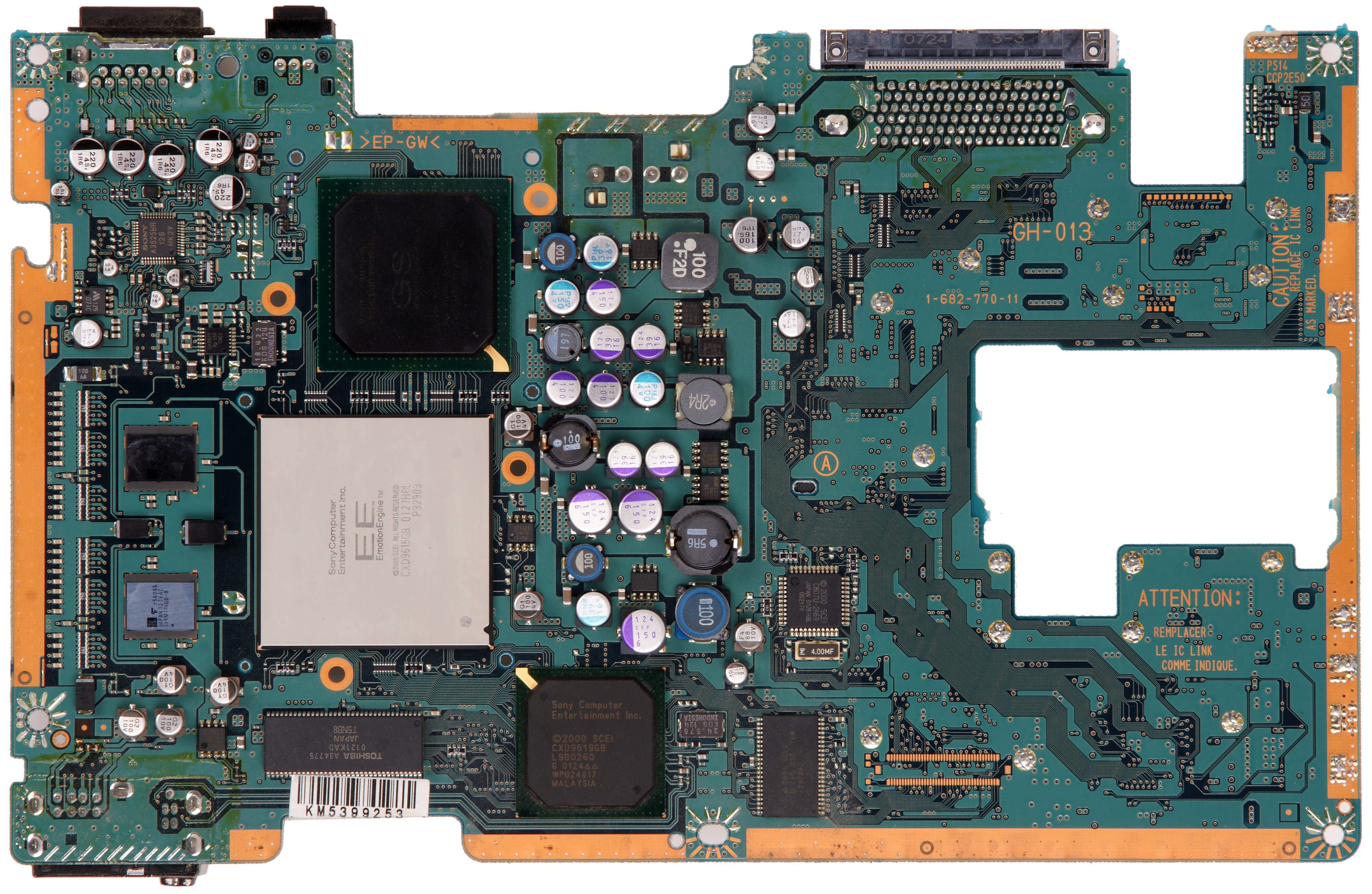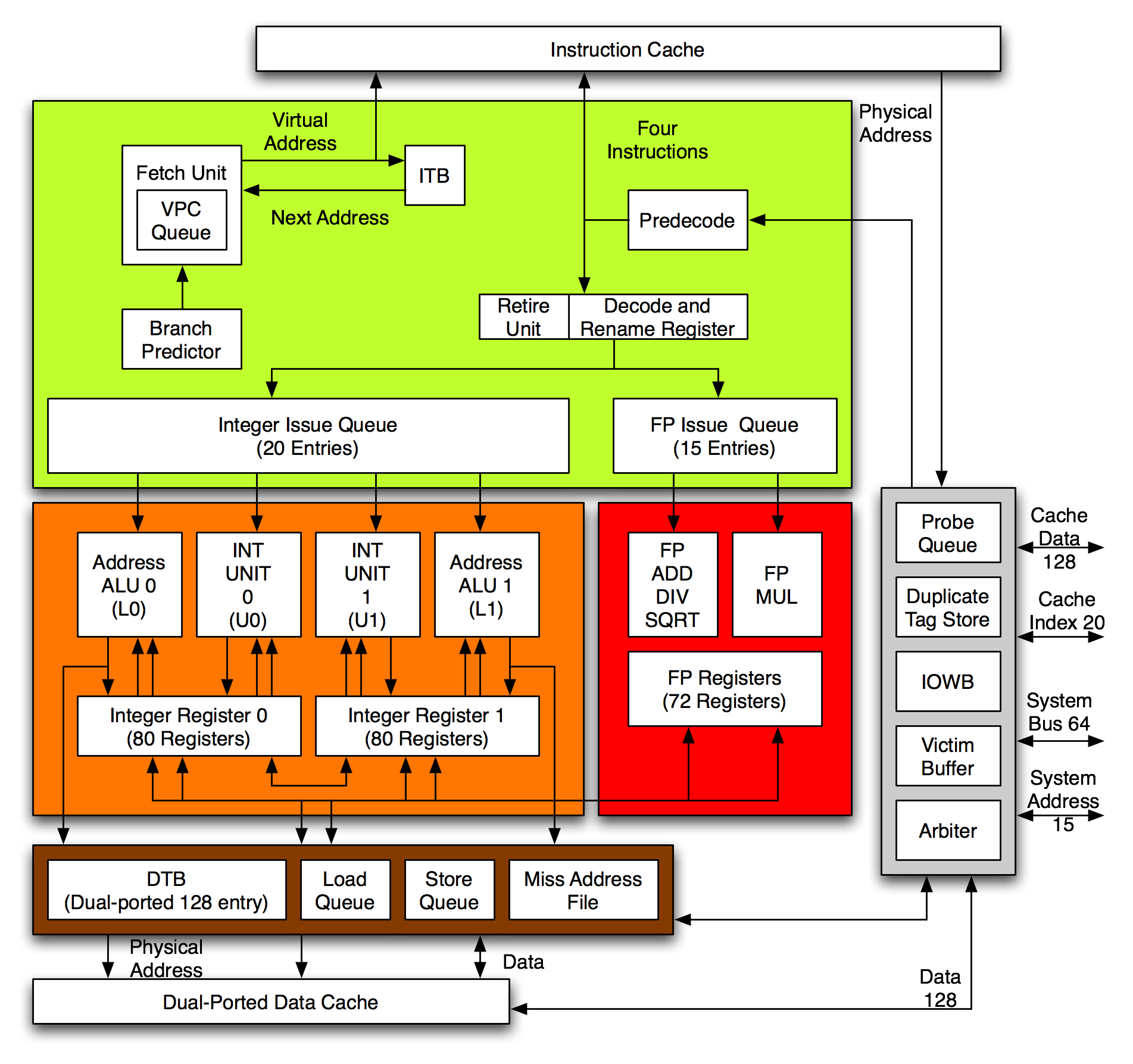|
250 Nanometer
The 250 nanometer (250 nm or 0.25 µm) process refers to a level of semiconductor process technology that was reached by most manufacturers in the 1997–1998 timeframe. Products featuring 250 nm manufacturing process *The DEC Alpha 21264A, which was made commercially available in 1999. *The AMD K6-2 ''Chomper'' and ''Chomper Extended''. Chomper was released on May 28, 1998. *The AMD K6-III "Sharptooth" used 250 nm. *The mobile Pentium MMX ''Tillamook'', released in August 1997. *The Pentium II '' Deschutes''. *The Pentium III '' Katmai''. *The Dreamcast's CPU and GPU. *The initial version of the Emotion Engine processor used in the PlayStation 2 The PlayStation 2 (PS2) is a home video game console developed and marketed by Sony Computer Entertainment. It was first released in Japan on 4 March 2000, in North America on 26 October 2000, in Europe on 24 November 2000, and in Australia on 3 .... *00250 Computer-related introductions in 1998 ... [...More Info...] [...Related Items...] OR: [Wikipedia] [Google] [Baidu] |
Digital Equipment Corporation
Digital Equipment Corporation (DEC ), using the trademark Digital, was a major American company in the computer industry from the 1960s to the 1990s. The company was co-founded by Ken Olsen and Harlan Anderson in 1957. Olsen was president until forced to resign in 1992, after the company had gone into precipitous decline. The company produced many different product lines over its history. It is best known for the work in the minicomputer market starting in the mid-1960s. The company produced a series of machines known as the PDP line, with the PDP-8 and PDP-11 being among the most successful minis in history. Their success was only surpassed by another DEC product, the late-1970s VAX "supermini" systems that were designed to replace the PDP-11. Although a number of competitors had successfully competed with Digital through the 1970s, the VAX cemented the company's place as a leading vendor in the computer space. As microcomputers improved in the late 1980s, especially wit ... [...More Info...] [...Related Items...] OR: [Wikipedia] [Google] [Baidu] |
Katmai (microprocessor)
The Pentium III (marketed as Intel Pentium III Processor, informally PIII or P3) brand refers to Intel's 32-bit x86 desktop and mobile CPUs based on the sixth-generation P6 microarchitecture introduced on February 28, 1999. The brand's initial processors were very similar to the earlier Pentium II-branded processors. The most notable differences were the addition of the Streaming SIMD Extensions (SSE) instruction set (to accelerate floating point and parallel calculations), and the introduction of a controversial serial number embedded in the chip during manufacturing. The Pentium III is also a single-core processor. Even after the release of the Pentium 4 in late 2000, the Pentium III continued to be produced with new models introduced until early 2003, and were discontinued in April 2004 for desktop units, and May 2007 for mobile units. Processor cores Similarly to the Pentium II it superseded, the Pentium III was also accompanied by the Celeron brand for lower-end versions, ... [...More Info...] [...Related Items...] OR: [Wikipedia] [Google] [Baidu] |
CMOS
Complementary metal–oxide–semiconductor (CMOS, pronounced "sea-moss", ) is a type of metal–oxide–semiconductor field-effect transistor (MOSFET) fabrication process that uses complementary and symmetrical pairs of p-type and n-type MOSFETs for logic functions. CMOS technology is used for constructing integrated circuit (IC) chips, including microprocessors, microcontrollers, memory chips (including CMOS BIOS), and other digital logic circuits. CMOS technology is also used for analog circuits such as image sensors (CMOS sensors), data converters, RF circuits (RF CMOS), and highly integrated transceivers for many types of communication. The CMOS process was originally conceived by Frank Wanlass at Fairchild Semiconductor and presented by Wanlass and Chih-Tang Sah at the International Solid-State Circuits Conference in 1963. Wanlass later filed US patent 3,356,858 for CMOS circuitry and it was granted in 1967. commercialized the technology with the trademark "COS-MO ... [...More Info...] [...Related Items...] OR: [Wikipedia] [Google] [Baidu] |
180 Nanometer
The 180 nm process refers to the level of MOSFET (CMOS) semiconductor process technology that was commercialized around the 1998–2000 timeframe by leading semiconductor companies, starting with TSMC and Fujitsu, then followed by Sony, Toshiba, Intel, AMD, Texas Instruments and IBM. The origin of the 180 nm value is historical, as it reflects a trend of 70% scaling every 2–3 years. The naming is formally determined by the International Technology Roadmap for Semiconductors (ITRS). Some of the first CPUs manufactured with this process include Intel Coppermine family of Pentium III processors. This was the first technology using a gate length shorter than that of light used for contemporary lithography, which had a wavelength of 193 nm. Some more recent microprocessors and microcontrollers (e.g. PIC) are using this technology because it is typically low cost and does not require upgrading of existing equipment. In 2022, Google sponsored open-source hardware p ... [...More Info...] [...Related Items...] OR: [Wikipedia] [Google] [Baidu] |
350 Nanometer
The 350 nanometer (350 nm) process refers to the level of semiconductor process technology that was reached in the 1995–1996 timeframe by leading semiconductor companies like Intel and IBM. Products featuring 350 nm manufacturing process * MTI VR4300i (1995), used in the Nintendo 64 game console. * Intel Pentium ( P54CS, 1995), Pentium Pro (1995) and initial Pentium II CPUs ( Klamath, 1997). * AMD K5 (1996) and original AMD K6 (Model 6, 1997) CPUs. * МЦСТ-R150 (2001). * Parallax Propeller The Parallax P8X32A Propeller is a multi-core processor parallel computer architecture microcontroller chip with eight 32-bit reduced instruction set computer (RISC) central processing unit (CPU) cores. Introduced in 2006, it is designed and sold ... (2006), 8 core microcontroller. References *00350 1995 introductions {{nano-tech-stub ... [...More Info...] [...Related Items...] OR: [Wikipedia] [Google] [Baidu] |
PlayStation 2
The PlayStation 2 (PS2) is a home video game console developed and marketed by Sony Computer Entertainment. It was first released in Japan on 4 March 2000, in North America on 26 October 2000, in Europe on 24 November 2000, and in Australia on 30 November 2000. It is the successor to the original PlayStation (console), PlayStation, as well as the second installment in the PlayStation brand of consoles. As a sixth generation of video game consoles, sixth-generation console, it competed with Nintendo's GameCube, and Microsoft's Xbox (console), Xbox. It is the List of best-selling game consoles, best-selling video game console of all time, having sold over 155 million units worldwide. Announced in 1999, Sony began developing the console after the immense success of its predecessor. The PS2 offered Backward compatibility, backward-compatibility for its predecessor's DualShock#DualShock, DualShock controller, as well as its games. The PlayStation 2 received widespread critical accla ... [...More Info...] [...Related Items...] OR: [Wikipedia] [Google] [Baidu] |
Emotion Engine
The Emotion Engine is a central processing unit developed and manufactured by Sony Computer Entertainment and Toshiba for use in the PlayStation 2 video game console. It was also used in early PlayStation 3 models sold in Japan and North America (Model Numbers CECHAxx & CECHBxx) to provide PlayStation 2 game support. Mass production of the Emotion Engine began in 1999 and ended in late 2012 with the discontinuation of the PlayStation 2. Description The Emotion Engine consists of eight separate "units", each performing a specific task, integrated onto the same die. These units are: a CPU core, two Vector Processing Units (VPU), a 10-channel DMA unit, a memory controller, and an Image Processing Unit (IPU). There are three interfaces: an input output interface to the I/O processor, a graphics interface (GIF) to the graphics synthesizer, and a memory interface to the system memory. The CPU core is tightly coupled to the first VPU, VPU0. Together, they are responsible for exe ... [...More Info...] [...Related Items...] OR: [Wikipedia] [Google] [Baidu] |
Dreamcast
The is a home video game console released by Sega on November 27, 1998, in Japan; September 9, 1999, in North America; and October 14, 1999, in Europe. It was the first sixth-generation video game console, preceding Sony's PlayStation 2, Nintendo's GameCube and Microsoft's Xbox, and it was Sega's final console, ending the company's eighteen years in the console market. The Dreamcast was developed by an internal Sega team led by Hideki Sato. In contrast to the expensive hardware of the unsuccessful Saturn, the Dreamcast was designed to reduce costs with "off-the-shelf" components, including a Hitachi SH-4 CPU and an NEC PowerVR2 GPU. Sega used the GD-ROM media format to avoid the expenses of DVD-ROM technology and a custom version of the Windows CE operating system to make porting PC games easy. The Dreamcast was the first console to include a built-in modular modem for internet access and online play. Though released in Japan to a subdued reception, the Dreamcast ha ... [...More Info...] [...Related Items...] OR: [Wikipedia] [Google] [Baidu] |
Pentium III
The Pentium III (marketed as Intel Pentium III Processor, informally PIII or P3) brand refers to Intel's 32-bit x86 desktop and mobile CPUs based on the sixth-generation P6 microarchitecture introduced on February 28, 1999. The brand's initial processors were very similar to the earlier Pentium II-branded processors. The most notable differences were the addition of the Streaming SIMD Extensions (SSE) instruction set (to accelerate floating point and parallel calculations), and the introduction of a controversial serial number embedded in the chip during manufacturing. The Pentium III is also a single-core processor. Even after the release of the Pentium 4 in late 2000, the Pentium III continued to be produced with new models introduced until early 2003, and were discontinued in April 2004 for desktop units, and May 2007 for mobile units. Processor cores Similarly to the Pentium II it superseded, the Pentium III was also accompanied by the Celeron brand for lower-end versions ... [...More Info...] [...Related Items...] OR: [Wikipedia] [Google] [Baidu] |
Alpha 21264
The Alpha 21264 is a Digital Equipment Corporation RISC microprocessor launched on 19 October 1998. The 21264 implemented the Alpha instruction set architecture (ISA). Description The Alpha 21264 is a four-issue superscalar microprocessor with out-of-order execution and speculative execution. It has a peak execution rate of six instructions per cycle and could sustain four instructions per cycle. It has a seven-stage instruction pipeline. Out of order execution At any given stage, the microprocessor could have up to 80 instructions in various stages of execution, surpassing any other contemporary microprocessor. Decoded instructions are held in instruction queues and are issued when their operands are available. The integer queue contained 20 entries and the floating-point queue 15. Each queue could issue as many instructions as there were pipelines. Ebox The Ebox executes integer, load and store instructions. It has two integer units, two load store units and two integer r ... [...More Info...] [...Related Items...] OR: [Wikipedia] [Google] [Baidu] |
Deschutes (microprocessor)
The Pentium II brand refers to Intel's sixth-generation microarchitecture (" P6") and x86-compatible microprocessors introduced on May 7, 1997. Containing 7.5 million transistors (27.4 million in the case of the mobile Dixon with 256 KB L2 cache), the Pentium II featured an improved version of the first ''P6''-generation core of the Pentium Pro, which contained 5.5 million transistors. However, its L2 cache subsystem was a downgrade when compared to the Pentium Pros. It is a single-core microprocessor. In 1998, Intel stratified the Pentium II family by releasing the Pentium II-based Celeron line of processors for low-end workstations and the Pentium II Xeon line for servers and high-end workstations. The Celeron was characterized by a reduced or omitted (in some cases present but disabled) on-die full-speed L2 cache and a 66 MT/s FSB. The Xeon was characterized by a range of full-speed L2 cache (from 512 KB to 2048 KB), a 100 MT/s FSB, a different physical ... [...More Info...] [...Related Items...] OR: [Wikipedia] [Google] [Baidu] |
Pentium II
The Pentium II brand refers to Intel's sixth-generation microarchitecture (" P6") and x86-compatible microprocessors introduced on May 7, 1997. Containing 7.5 million transistors (27.4 million in the case of the mobile Dixon with 256 KB L2 cache), the Pentium II featured an improved version of the first ''P6''-generation core of the Pentium Pro, which contained 5.5 million transistors. However, its L2 cache subsystem was a downgrade when compared to the Pentium Pros. It is a single-core microprocessor. In 1998, Intel stratified the Pentium II family by releasing the Pentium II-based Celeron line of processors for low-end workstations and the Pentium II Xeon line for servers and high-end workstations. The Celeron was characterized by a reduced or omitted (in some cases present but disabled) on-die full-speed L2 cache and a 66 MT/s FSB. The Xeon was characterized by a range of full-speed L2 cache (from 512 KB to 2048 KB), a 100 MT/s FSB, a different physical ... [...More Info...] [...Related Items...] OR: [Wikipedia] [Google] [Baidu] |





